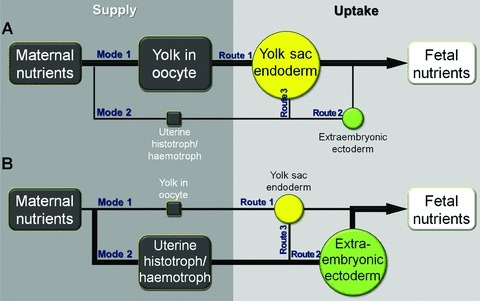Figure 2.

Variations in maternal nutrient supply and embryonic nutrient uptake. On the maternal side, nutrients are either deposited in the oocyte internally during its maturation (vitellogenesis) (mode 1) or provided to the developing embryo externally from the oviduct/uterus through either simple apposition of fetal and maternal tissues or complex placentation (collectively termed uterine histotroph/hemotroph here) (mode 2). Nutrients in the oocyte are taken up by the embryo through the yolk sac endoderm (route 1), and nutrients in the uterine histotroph/hemotroph are taken up by either the extraembryonic ectoderm (chorionic ectoderm or trophectoderm) (route 2) or the yolk sac endoderm (route 3). (A) In avian embryos, mode 1 and route 1 are dominant. (B) In eutherian embryos, mode 2 and route 2 are dominant. But in all amniote embryos, both maternal supply modes and all three nutrient uptake routes are operational, and the importance of route 3 transfer in mammalian embryos has been underappreciated.
